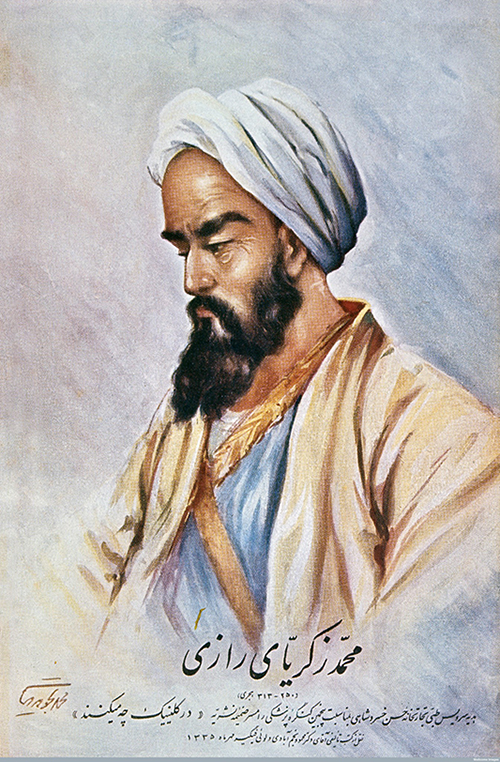Ninth Book of the Al’Mansuri. With commentary of Geraldus de Solo. Translated into Hebrew by Tobiel ben Samuel de Leiria. Portugal, 1388.
 During the Middle Ages, the Arab world preserved the knowledge of the Greeks and Romans and continued to flourish intellectually while Europe lay dormant. One of the great Arab physicians of that era was Al-Razi, known in the West as Rhazes. Born in Persia, he studied in Baghdad, Palestine, Egypt and Spain. Later he taught and directed hospitals in his home town, Rayy, Persia, and in Baghdad, where he became court physician. Rhazes also studied and wrote philosophical works, but these were not as well received as his medical writings. It was his descriptive and original clinical histories in the Hippocratic tradition that have gained him respect throughout history.
During the Middle Ages, the Arab world preserved the knowledge of the Greeks and Romans and continued to flourish intellectually while Europe lay dormant. One of the great Arab physicians of that era was Al-Razi, known in the West as Rhazes. Born in Persia, he studied in Baghdad, Palestine, Egypt and Spain. Later he taught and directed hospitals in his home town, Rayy, Persia, and in Baghdad, where he became court physician. Rhazes also studied and wrote philosophical works, but these were not as well received as his medical writings. It was his descriptive and original clinical histories in the Hippocratic tradition that have gained him respect throughout history.
Rhazes is well-known for his description of smallpox and measles, the first authentic account of these diseases (Garrison 129). He was also the first to distinguish these two diseases from each other and to propose the theory of acquired immunity by recognizing that individuals surviving smallpox never get it again (Garrison & Morton, 5441 & 2527.99). Other contributions to the field of medicine include several innovations in pharmacy and chemistry. He developed many chemical apparatuses used up to the beginning of the twentieth century, and he wrote a manual that classified chemicals and described procedures for their mixing and preparation that were later adopted by the Western world (Flannery 6).
Based primarily on Greek medicine, the Al’ Mansuri is Rhazes’s ten part textbook and encyclopedia of medicine. The title of the Ninth Book translates into English as Exposition of the ninth part of Rhazes (dealing with) the diseases from head to foot (Flannery 6). This famous pathology textwas used in the teaching of therapeutics until well after the Renaissance (Garrison 129). Since the ninth book was so popular, it was often published alone (Sarton 609). One of the Reynolds-Finley Historical Library’s oldest and most rare materials is a Hebrew translation of the Ninth Book of Al’Mansuri which was completed in 1388. The translator is Tobiel ben Samuel, who identifies himself in the introduction as a Jewish physician from Portugal and student of Moses de Leira. Tobiel translated the work from the Latin version done by famous professor, Gerard de Solo of Montpellier University, in 1344. Of the three known translations of this text, the Reynolds-Finley copy is the only one with the original title page, preface and other introductory material intact (Flannery 5). And it is important culturally as a symbol of the Arabic preservation and advancement of knowledge in the Middle Ages and the role of Jewish scholarship in transferring it to the West (Flannery 6).
Flannery, [In] The Watermark, Vol. 23, No. 1, Winter, 1999-2000, pp. 5-7; Garrison, Hist. Med.,4th Edition, p. 129; Garrison & Morton, Med. Bib., 5th Edition, 2527.99 & 5441; Heirs of Hippocrates, 34-36; Reynolds Historical Library, Rare books and coll…, 5088; Sarton, Intro. to the Hist. of Sci., Vol. I, p. 609.
Image: Portrait of Rhazes (al-Razi) (AD 865 - 925) physician and alchemist who lived in Baghdad. Wellcome Images Wellcome Library, London.
